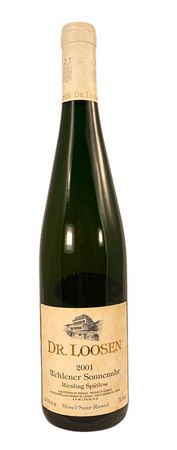NOTE: This wine is in the 'Aromatic, Textural and Lightweight category, but this is an off-dry to sweet wine. It has amazing acidity which doesn't leave it cloying, hence why it is NOT in the 'Sweet Wine' category.
Dr. Loosen Wehlener Sonnenuhr Riesling Spätlese is grown on a precipitously steep, rocky vineyard that consistently yields some of the most elegant and sophisticated white wines in the world. The mineral-rich, blue Devonian slate soil produces quintessential Mosel Riesling: delicate and refined, with racy minerality.
SPÄTLESE Spätlese is German for "late-harvested". The wines usually have more richness and body than Kabinett because the grapes are allowed to ripen for an extra week or more. Once harvested, the wine can be fermented fruity (“lieblich”), half-dry (halbtrocken) or dry (trocken), depending on the winemaker’s preference.
VDP GROSSE LAGE designates the very best vineyards of Germany, within which the finest parcels have been narrowly demarcated. With their site-specific characteristics, these wines are particularly expressive and have exceptional aging potential. They are planted with traditional varieties best suited to a particular site, as determined by each region. A dry wine from a VDP Grosse Lage is designated VDP Grosses Gewächs and labelled “Qualitätswein trocken”. A wine with natural, ripe sweetness from a VDP Grosse Lage is labelled with one of the traditional Prädikats: Kabinett, Spätlese, Auslese, Beerenauslese, Eiswein or Trockenbeerenauslese. The maximum yield is 50hl/ha. The grapes have to be harvested by hand and the sugar content has to be at least at Spätlese level. The sweet VDP Grosse Lage wines are presented on 1st may. The white VDP Grosses Gewächse are presented on 1st September, the red VDP Grosses Gewächse one year later.
James Halliday Collection Bottle Number(s): 0443, 0444, 0445. Cork. Minor label stains. Ullage is to the bottom of the capsule - incredible.
Wine Profile
Vineyard Notes
Situated on Germany’s Mosel River among some of the world’s most treasured vineyards, the Dr. Loosen estate has been in the same family for more than 200 years. When Ernst Loosen (pronounced LOH-zen) assumed ownership in 1988, he realized that, with ungrafted vines averaging 60 years old in some of Germany’s top-rated vineyards, he had the raw materials to create stunningly intense, world-class Rieslings. To achieve this, Ernst immediately changed the estate’s vineyard practices to dramatically reduce crop size. He stopped all chemical fertilization, preferring only moderate use of organic fertilizers and soil amendments. He extended his commitment to sustainable practices beyond the vineyards and into the winery, implementing improvements in materials recycling, energy efficiency and water conservation.
Production Notes
This Riesling comes from ungrafted vines with an average age of 60 years. The vineyard is sustainably farmed, according to strict German environmental regulations. Selectively hand-harvested grapes underwent cool fermentation in stainless steel tanks and traditional Fuder barrels. Half of the juice was fermented with natural yeasts, the other half with cultured yeasts. Fermentation was arrested by chilling
Winemaker Notes
The Mosel’s steep, south-facing slopes create the perfect climate for Riesling, giving the vines ideal exposure to the sun. Generally cool conditions allow the grapes to ripen slowly while retaining bright acidity. Rocky outcroppings and stony soil reflect sunlight and hold in heat, creating very warm microclimates in the best sites and helping to ensure excellent ripeness. Thin topsoil forces the vines to dig deep for water and nutrients, producing vibrant wines that capture the strong minerality of the soil. Dr. Loosen’s single-vineyard vines average 70 years old, all on original rootstock (phylloxera can’t survive in the Mosel, so ungrafted vines are allowed here). Old vines produce naturally lower yields, resulting in higher concentration and richness.
Other Notes
James Halliday Persoanl Collection. Allocation Only

